The stereotype about the Homeric Heroes is about well armoured Warriors with swords and spears fighting in duels or primitive phalanxes/loose formations. Some of them were exceptional archers using composite bows (eg. Pandaros, Odysseus). Αrchaeological findings among Egyptians, Mitannians, Caananites, Hittites, Summerians present us a large variety of «exotic» weapons like periform maces, disc maces, sickle swords, throwing sticks, heavy naval spears, etc.
It is a fact though that Homer describes briefly some unusual (and less-noble) weapons, like axes clubs (Iliad 7.138) and aksini (Iliad 15.711). War clubs maces were typical weapons of the Bronze era. Homer describes it as great bar clubbed of iron (Iliad 7.138). Findings of spherical or periphorm maces document their usage in all armies of the era (Egypt, Hittite Kingdom, North Europe, Mycenaeans, etc). Various materials were used to build war maces (iron, bronze, stone), depending of the social status and financials of the Warrior. Some archaeological findings though (Agia Triada near Phaistos/Crete) present us some exceptional examples of mallet war maces.
Bronze Age Mycenaean technology was capable of producing highly effective plate and scale armours for the Warriors in massive numbers, as Mycenaean and Minoan logistics documents reveal. It is a safe guess to assume that Kanellopoulos Museum artifact was a weapon with the necessary shape and mass to deliver effective crushing blows and perforate the composite panoplies of the era.
KORYVANTES Association has build a copy of the Kanellopoulos Museum axini artifact – we had to visit the Museum for a close study, as the Museum policy does not allow photographing the exhibits. We decided to reconstruct with slightly larger dimensions to fit to modern human body better. The result is a heavy hammer (4 kg) with a distinctive shape that reminds the head/beak of exotic birds. The pole was built using hardened olive-tree wood. A number of Epsilon axes have built, both heavy two-handed version and light singe-handed ones. Again, the poles were built using hardened olive-tree wood.
Navmaho xisto (?) – heavy naval spear / boarding pick
Homer refers to
navmaha xista (ναύμαχα ξυστά) – boarding picks (Iliad. Ο. 388 – 389, 676 – 678), as special weapons of Achaeans for naval warfare. Our inspiration for this type of weapons was an image from the exceptional site of
Andrea Salimbeti. The peculiar
bronze double-headed blade is dated around 16th Century BC found at
Agios Onoufrios near
Phaistos, Crete. The shape of the artifact loosely reminds an agricultural tool called
δικράνι –
dikrani, some refer to the artifact with this term.
Officially this artifact has been interpreted as a fish-spear. This may have been used in conjunction with a net, or on its own from an open boat. We assume that was used like a harpoon to kill captured large fishes (swordfish) or sea mammals (seals, whales, dophins) – the heavyweight spearhead fit perfectly in this scenario (vertical hit from boat decks downwards to sea level), multiplying the forces and delivering devastating power to penetrate the thick skin of the pray. Also the shape of the spearhead seem to be ideal for the role, though we conducted no tests for this.
Another interesting interpretation for this artifact is that is a social or religious symbol, as the shape is similar to the most characteristic
Minoan religious symbol, the horns of the «sacred bull»
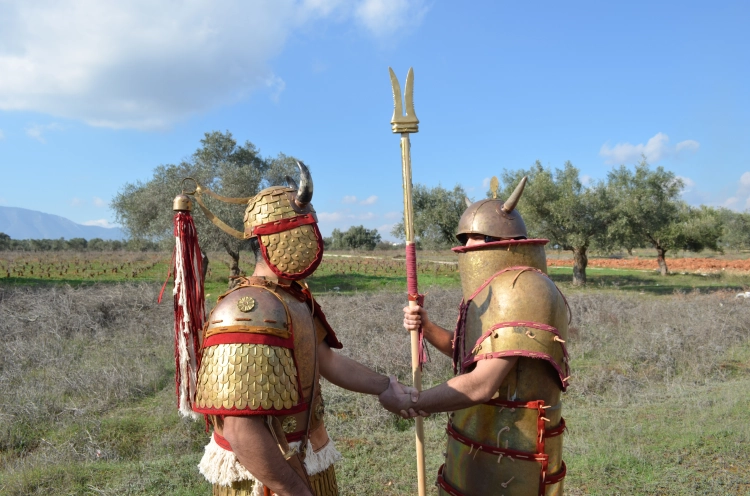
Early Mycaenean Warrior, armed with Naumahon Xisto (?) – boarding pike.
The peculiar bronze double-headed blade is dated around 16th Century BC found at Agios Onoufrios near Phaistos Crete.
Association of Historical Studies KORYVANTES
But Andrea Salimbeti also marks a very interesting
reference of Homer (Iliad XV, 712) about this kind(?) of double-head spear and its utilization during the battle inside the Achaean camp just around the ships. We do endorse this interpretation, thus initiated the project to build and test this very special weapon. It was not possible to have access to the artifact or data related to it, so our armourer followed the instructions of Mr Salimbeti to build a copy of it. The first attempt lead to an exceptionally heavy spearhead (around 6 kg), after a lot of work on trimming we managed to reduce the weight to around 4 kg. It is in our plans to ask for physical access to the artifact and validate the correctness of our reconstruction – we will update the findings accordingly, when available.
Fight drills
There is a quite a few quality material on Bronze age warfare and weapon tactics. Many academics and martial-artists have studied extensively the (limited) written evidence of the era and the archaeology findings, then combined them with expertise and more contemporary knowledge (Liechtenauer, Joachim Meÿer) as basis of their interpretations and document their findings. A few people worldwide have rebuild quality bronze age armour and weapons and got significant practical expertise in the field.
The decision of the Association to invest internally in building custom museum-quality reproductions of various bronze age civilizations, not only has created a collection of 4 complete panoplies and weaponry, but also has created an extensive knowledge on the whole lifecycle of building / supporting /using / maintaining them. In this short study, we have worked with a copy of early Mycenaean
Dendra armour, a hybrid Hittite/Trojan armour that combine elements of Mycaenean plate and Hittite scale armour and a Sea people plate cuirass based on a depiction of
Medinet Habu, Mortuary Temple of Ramesses III, Luxor.
The key element of the drills are the people who perform them. A combination of MMA practitioners and deep expertise from a certified trainer in Medieval martial arts / Fencing Coach, were utilized to perform, deliver and analyze the drills. In the following section are presented the drills/tests, details for the panoplies construction and some first thoughts. Deeper detailed analysis will be presented in future article.
Sea People Warrior fighting on ship deck. Combination of plate armour, wooden shield and Epsilon axe.
The plate armour designed and build by the Association armourer, is a very flexible piece of equipment. The cuirass was first presented at «Journées Gallo-Romaines St-Romain-en-Gal 2012» (Vienne, France), is part of an Association thesis submitted at Pultusk Academy in 2012, also presented at Experimental Archaeology Symposium 2014 (Viminacium Museum, Serbia). Detailed images of the cuirass and helmet from the site of the armourer.
Key characteristic of this cuirass is the flexibility and all round protection it offer to the Warrior body. It weight 14kg including the small bronze pauldrons and linen padding, but the shape and flexibility make it is comfortable for a trained person to carry it for more that 6 hours a day (cumulative) or 2 hours continuously. The main body of the consist of 12 plates attached together using an internal suspension system that is based on leather straps, plus 2 optional bronze pauldrons. The leather straps suspension allow the cuirass to adopt instantly to the body movements as permit the plates to shrink or expand on the vertical axis, but also allow the plates to micro-move on the horizontal axis and absorb the kinetic energy of incoming hits. Easy to remove leather straps connect the front and back parts of the cuirass, adding flexibility and security in emergency situation (remove the cuirass). The plates are placed overlapping on the horizontal axis and are supported by linen padding (20 layers of densely sewn linen). The overlapping placement of the plates plus the linen padding offer exceptional protection.
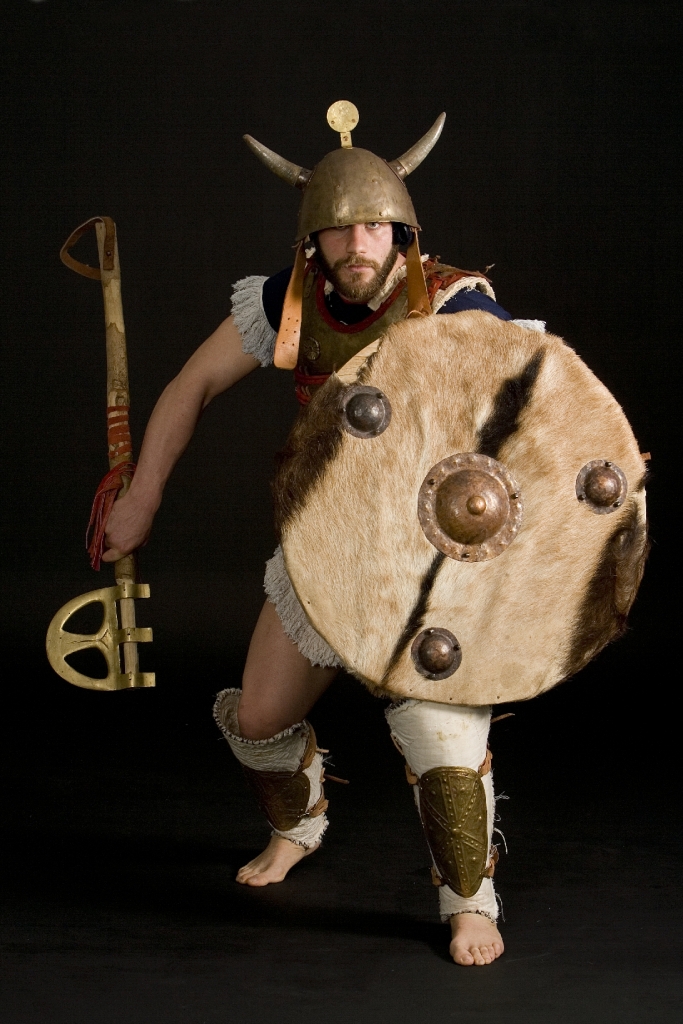
Sea People Warrior, armed with heavy Mycaenean Epsilon-type axe.
Reconstruction of a Sea People Armour and weapons, of the Dark ages. The cuirass is based on depiction from Medinet Habu, Mortuary Temple of Ramesses III, Luxor. Heavy, Epsilon-type axe and grieves are based on various Mycaenean artifacts of Greek Archeological Museums.
Association of Historical Studies KORYVANTES. Photo: Andreas Smaragdis
We consider this cuirass ideal for naval warfare, as it offer the required flexibility for fighting on the decks, but also can be easily removed in an emergency situation (if special leather straps are used). The following image depict a 12th – 10th century bc Warrior, who carries a heavy wooden shield (5Kg, made of simple wood planks with a vertical one-handed grip in the center and a large leather shoulder strap) and a heavy Epsilon axe. Linen grieves, reinforced with bronze elements, and a two-horned helmet decorated with a solar symbol are also part of the panoply. The whole system was very functional, except of the heavy shield… at later stage, we repeated the same drills with a lighter wicker shield, using the same handle system and leather / bronze reinforcements, that proved much more functional and operational.
The panoply cope effectively with the needs of the drill, as the Warrior could perform the required sharp movements and deliver explosive hits using the heavy epsilon axe in one-hand mode.The drill was simulating the movement in a confined crowded environment, typical of a small-sized warship of the era, and hand2hand close combat fight. Why simulated this scenario? Ships of 12th – 10th century bc were small, at the size of large kaiki (Mediterranean fishing boat), with limited space and many obstacles (eg. ropes) to make any large movements or use of large weapons impossible. In this scenario you engage fast in a closed distance fight where small weapons are preferable, and long weapons suddenly can loose their usability. Heavy weapons are also needed in such an environment as you might need to use them in an anti-material role (wood, ropes, heavy textiles). So a heavy Epsilon axe looks a good candidate to consider as it can be used in variety of modes (one-hand or two hands) and and roles (both anti-personnel and anti-material). If for some reason the warrior can not use his shield, this weapon is a nice tool for pin, break or smash enemy’s weapons. Also can be used as hook to deflect the enemy shield. If it is holding near the head, the warrior can use it to smash the enemy skull in very close combat.
Very interesting is how an
Epsilon axe can be used for close combat. Although the size and weight of this axe categorize it as two-handed weapon, we found that it can be easily used in one-hand mode for close quarters combat (cqc) scenarios. The semicircled shape moves the mass closer to the center of gravity, close to the hand grip, making it easily handled and very controllable in one-hand mode. The Warrior can deliver slashing attacks to the upper body/head of the opponent using the right angles – at the same time, the big mass of the bronze axe can be used to deliver bludgeoning attacks to the lower body of the opponent with devastating effects even against heavy armour. In this mode of use, the axe pole is actually used as a tail to balance the whole system. The inspiration came from a
Paulus Hector Mair (1517 – 1579) manuscript where halberds (pole weapon, much bigger that epsilon axe) are handled in a similar way in close distances.
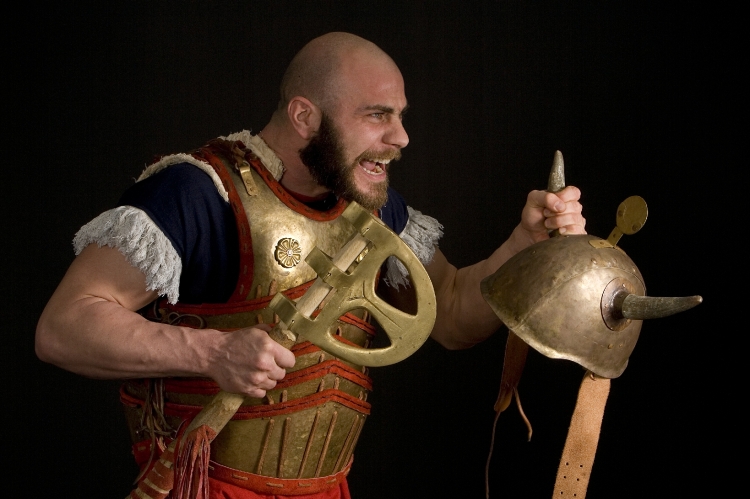
The image depict exactly the moment that the Warrior is engaged in a hand2hand fight and uses the upper part of the axe head to deliver devastating hits to the upper body / head of the opponent. Also depict the overlapping placement of the cuirass elements, the leather suspension of the plates and the additional linen padding bellow the plates.
Association of Historical Studies KORYVANTES. Photo: Andreas Smaragdis
No pauldrons (shoulder guards) were used during the drill. We believe that they have small value in a confined naval fight, where speed and sharp movements is the key factor for survival. Of course this is very subjective and we absolutely have no objection for other views. In any case, it can be combined with a variety of pauldrons… big or small, depending on the needs and the preferences of the Warrior or the fight environment… an example of the cuirass with large pauldrons (
front and
back sides).
Mycenaean Warrior vs Hittite/Trojan Warrior duel. Plate armour vs scale armour.
Dendra armour
Dendra armour is a very unique piece in the history of armour technology and evolution. Found in 1960 by Swedish archaeologist Paul Åstrom, close the small village of Dendra of South Greece, is the only one complete Mycenaean armour survived to date. From a civilization that spanned for more that 7 centuries and dominated East Mediterranean (and parts of Central Europe), we only have a single intact complete panoply, although armour of similar type appears to be in massive usage by Mycenaean Kingdoms. There is a second armour of type, an improved variant, found in the Thebes (Central Greece). An interesting fact about Dendra armour is that it is completely intact with no battle damage(s), meaning that never used in the battle field
Although the Dendra armour is dated to the end of the fifteenth century bc, there is evidence that similar type of armour (or parts of) was used even during Troy war – officially dated to the 12th century bc. According to Spyros Bakas, even though the description is not clear enough, the Cuirass of the son of Phyleus could be a Dendra-type armour [2]. Andrea Salimbeti points to another key reference in the Iliad about this kind of armour (or more likely the improved variant found in Thebes) is when Achilles put on his sacred armour, in fact he tested it to see if it allowed his limbs free movement. This would be essential for anyone wearing a typical Achaean armour with large shoulder guards and girdle plates. Of course this would not be necessary if he were wearing a much simpler cuirass or corselet. (Il. XIX, 384-386).
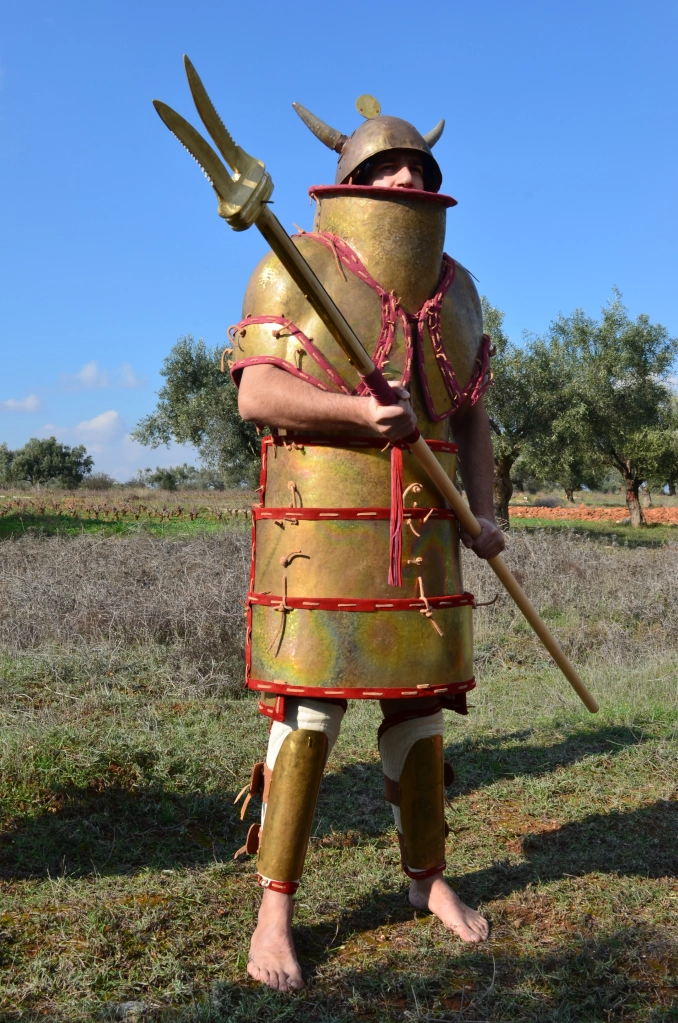
Early Mycaenean Warrior, armed with Naumahon Xisto (?) – boarding pike.
Reconstruction of a Mycaenean armour and weapons. The Mycaenean plate armour is an exact copy of the Dendra armour, presented in Nafplion Archeological Museum. The peculiar bronze double-headed blade is dated around 16th Century BC found at Agios Onoufrios near Phaistos Crete. The helmet is based on depiction from Medinet Habu, Mortuary Temple of Ramesses III, Luxor.
Association of Historical Studies KORYVANTES
When initiated the project to build a Denda type armour, we studied the book of Paul Åstrom, but also our armourer spent 1 day in Nafplion Museum to study (as close as possible) the original and keep notes on the construction. Key question for us was to understand the suspension method of the curved plates, as this would alter dramatically the functionality of the armour. According to Paul Åstrom, the weight of the metal parts (roughly 1mm thick) found is 15 kg, designed to fit a person 1.70 – 1.75 cm tall. We can assume 2 kg of additional weight for leather trimming, straps and linen parts. The main difference of our construction from the original is the size, as we build it to fit to taller men (1.85 – 1.90).
For the construction we started with bronze plates, hammering was used to form all parts, no english wheel was used. This is obvious from the surface that keep the marks of the hammering visible, even after many cycles of extensive polishing. Weight including leather trimming on plates edges, leather straps for suspending the plates and linen padding totaled 25+kg. Regarding the suspension of the plates, we setup a system where the front and back curved plates behave in a different way. Three pairs of curved plates hang from the waist to protect the groin and the thighs. In our setup, the three front curved plates can shrink or expand on the vertical axis, the three back curved plates are fixed together forming a single surface. Also the front and back plates are not connected. This setup allows the Warrior to bend in order to use the long spear effectively, as shown in the following image.

Association of Historical Studies KORYVANTES
There is also the deep gorget protecting the neck and lower part of the face. The Linear B ideogram depicting armour of this type makes the neck-guard clearly discernible, so it was a common practice at this time. Gorgets of this type and in similar proportions also appear in Egyptian depictions (Tombs of Kenamun, Tomb of Paimosi). The original half front is rather conical, for technical reasons it was difficult to reproduce the exact shape. We kept the same proportions, covering the lower part of the face – we found this very restrictive, as limits the vision dramatically and isolates he Warrior from his body completely. Although the Warrior is capable to perform all movements and drills, we is not aware of the environment 1+ meter around his body. In a next version we decided to rebuild the gorget slightly shorter (-3 cm) to increase the field of vision.
Hittite / Trojan composite armor
We refer to this armor as «hybrid» since it is a combination of Mycenaean plate armour cuirass and Near East scale armour tassets and pauldrons/sleeves – for the construction of the armour and helmet, 5 different types of scales have been used from Egypt, Hittite and Assyria. This was intentional as we wanted to focus on a Warrior of the Troy war.
The armor consist of a bronze breastplate, a reinforced war-belt, 2 couples of large tassets with bronze scales (of two types) attached on linen, overlapping on vertical and horizontal axis and bronze pauldrons / sleeves with bronze scales overlapping on vertical and horizontal axis. The helmet was built using bronze scales of two types and sizes. The result is composite armor (bronze, linen, leather) with a total weight is around 17kg.
By nature, the modular design is very flexible operational-wise as it can be commissioned in various modes depending on the tactical situation and the user. For instance, an archer may be issued the armor without pauldrons, so that he is able to easily use his bow without being hindered. If tactical situation require speed, the tassets can be easily removed, so the Warrior is able to quickly change position or retreat without becoming entangled in the armoured skirts. Also the weight is affordable and distributed evenly on shoulders and hips, allowing to be used from chariot driver and/or chariot Warrior/archer, a common practice of Hittite fight tactics.
The result is a rich armor, very effective to absorb the kinetic energy of the hits, complex to build but capable to provide extreme protection against the weapons of the era. The cost of building an armor of this type was exceptional, only highest ranking officers or elite troops would be commissioned with such arms (some statistics describe a ratio of 5000:1 for commissioning bronze scale armor in the Hittite and Egyptian armies)
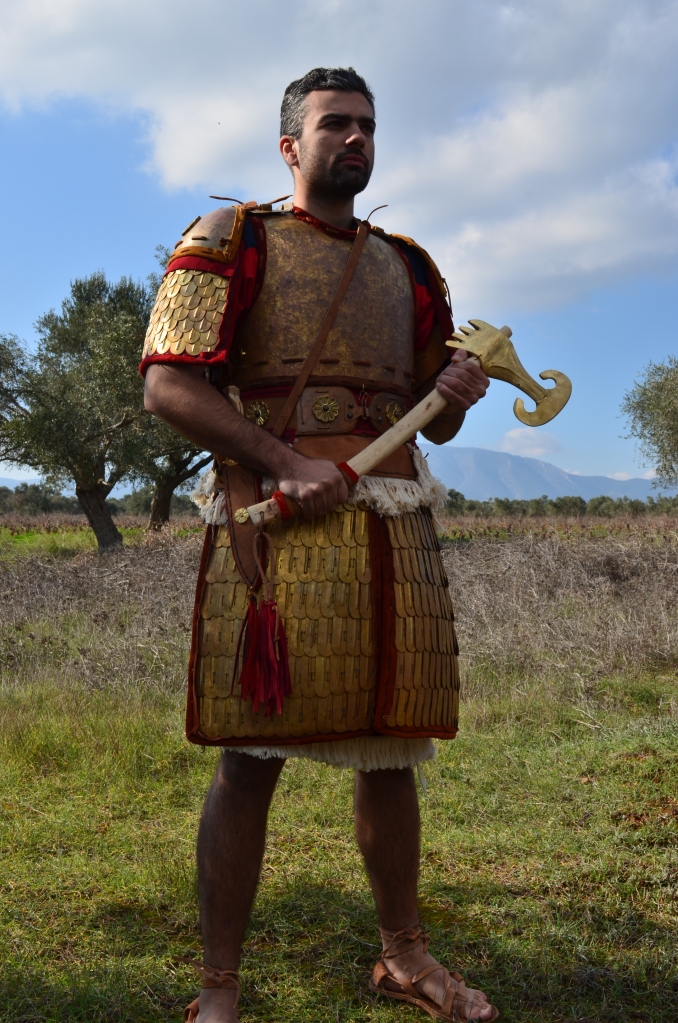
Hittite / Trojan Warrior, armed with warthog axe.
Reconstruction of an Hittite / Trojan armor and weapons of the Hattusa Kingdom. The hybrid cuirass combines elements of Hittite / Assyrian / Egypt scale armors and Mycaenean plate armor. Axe, based on depiction of King’s Gate at Hattusa, is shaped like warthog teeths.
Association of Historical Studies KORYVANTES
Fight Drills
It is a mystery how a Dendra-type panoplies was deployed in the battlefields of 1500 – 1200 bc
[3]. There are no written evidence on how Dendra type of armor was used, but hundreds of this type of armor were commissioned from the Mycenaean kingdoms, as logistics Linear B tablets from Knossos (Sc series), Pylos (Sh series) and Tiryns (Si series) reveal
[4]. It is safe to assume that not all of them were made purely of bronze plates, probably most of them were composite designs of leather, linen and metal reinforcements (
detailed images of a Mycenaean composite armor reconstruction from the site of the armourer).
Assuming that all parts of Dendra armor were used, there is a full coverage of the body, including neck, lower part of the face and thighs. But the huge gorget isolate the Warrior from his body completely, thus the only weapons that can be used effectively with Dendra armour are long spears to keep opponents at a distance. In separate drills we conducted, indeed we found the armour very functional, if used without (or with a much smaller gorget) and 1 or 2 pairs of horizontal plates (instead of 3).
Apart of the gorget – can be easily removed if not needed – the key issue of this armor is the weight distribution: this is a 25+kg armor that weight is only distributed on shoulders… even well trained people cannot cope with this easily for long periods of time. One thought is to add a extra thick linen padding at the lower part of the cuirass (hips level) to fill the gap between the cuirass and the hips, so weight is more evenly distributed between hips and shoulders – this is a small project that we are just starting. Of course, Warriors with Dendra type armor did not walk extensive distances, they were moving on chariots (εποχούμενοι – epohoumenoi) to the place of interest and were supported by a number of servants / followers.
In our opinion , apart of ceremonial and victory parades, Dendra-type panoplies were commissioned to elite and well trained soldiers and moved to the battlefield to points where they would be most useful. The psychological effect of a number of elite Warriors with this type of armor would be tremendous. Also the tactical advantage that this type of armor offer, specially if the Warriors are supported by a number of lighter units, could be decisive in the battlefiled. We do not believe that this type of armor is ideal for duels, like the epic ones of Iliad – but we are open-minded and we can listen to any opinion.
We conducted various drills to test the functionality of both panoplies, simulating the fight of Mycaenean Warlord (carrying a sacred armor of earlier times…) armed with naftiko xisto against Troy Warrior (hybrid armor) armed with axini / Epsilon axe. Many fights like this would take place in the Achaean camp, when with Zeus’ help, the Trojans broke into the Achaean camp and were on the verge of setting fire to the Achaean ships. As a rule, if a Warrior with a pole arm (nautiko xisto) meet a warrior with smallest weapon (axini), the rule is that always he must keep the long distance and avoid the close combat for obvious reasons, instead the Warrior with small weapon must close the distance to have more probabilities to win the fight.

Association of Historical Studies KORYVANTES
Pic1. The Mycenaean Warrior is taking an aggressive stance, taking advantage of the long naytiko xisto, capable of delivering devastating hits to the opponent. The opponent is armed with a heavy axini, ideal weapon to grab the plate armor and submit his opponent. Pay attention on how the plate armor behave, as it easily follows the movements and does not restrict the Warrior… it was build in an ingenious way to provide total protection, at the same time it was engineered so that was able to totally expand and close (return to the original shape) instantly and effortlessly…

Association of Historical Studies KORYVANTES
Pic2. The Mycenaean Warrior bend slightly to the front to increase his (limited) field of vision, as is attacking the openings of the Trojan armor, eg the space between pauldron and cuirass or the neck/face of the opponent… the composite scale armor provide exceptional protection against hits, but cannot be formed with the extreme detail of the plate armor… note how the 3 front plates shrink to the vertical axis, as well as expand to the horizontal one to follow the body movement…
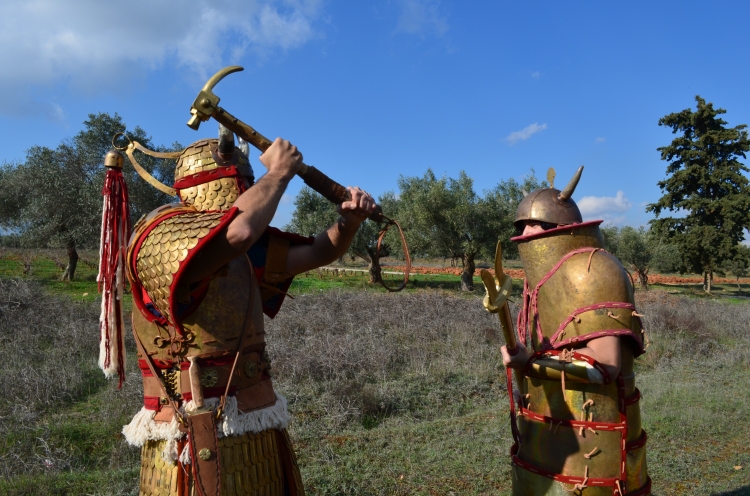
Association of Historical Studies KORYVANTES
Pic3. The Trojan Warrior with scale armor deflects the polearm and manages to close the distance an tries to grab through the plates with the beak of the axini… this is the most dangerous condition for the plate armor as the grabbing axini will turn to a strong fulcrum/lever system, will multiply the physical power of the attacker and the submission is almost inevitable… of course the Mycenaean Warrior can escape the pin of his enemy’s axini, simply letting his pole arm to fall down and grab his enemy with both hands to a deadly hug and start wrestling…

Association of Historical Studies KORYVANTES
Pic4. Axini beak has penetrated behind the right pauldron of the plate armor… now, it is extremely easy to grab the opponent to the ground… we do believe that axini is the ideal weapon against a Dendra type plate armor… there is no need to penetrate through the metal, just grab through the plates…
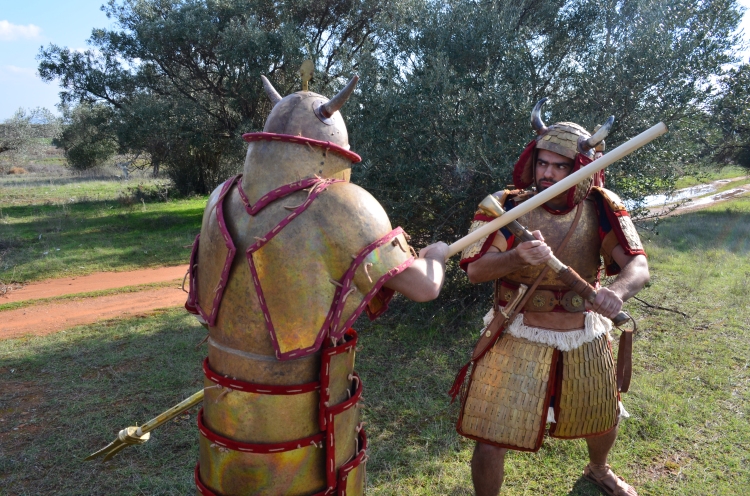
Association of Historical Studies KORYVANTES
Pic5. As a counter-attack, the Mycenaean Warlord is using the gravity so the heavy spearhead to turn downwards fast and the end of the long spear to remove the the axini grab and escape the sumbission… note the rear view of the Dendra armor… all the angles of the plates are ingeniously calculated and crafted to deflect the hits and avoid penetration… the image is closer to an insect, rather than human…
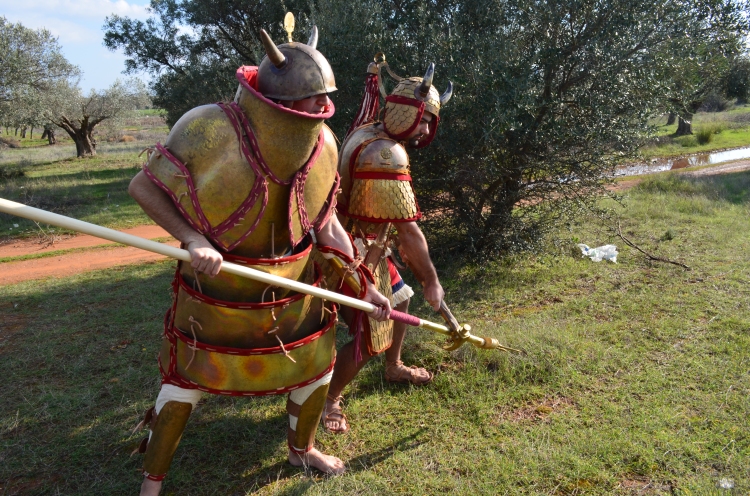
Association of Historical Studies KORYVANTES

Association of Historical Studies KORYVANTES
Pic6, Pic7. again axini shows its merits in close combat, as allow to grab enemy spear and guide to safe direction… in the following position, the axini can be easily used to reverse hit with the hammer and deliver heavy blunt hits over the armor
Various other drills were conducted by replacing the axini with the two-handed Epsilon axe and the one-handed warthoh axe. It turned that axini was proved the weapon of preference to use against plate armor. Warthog axe has similar usage to axini, but cannot be used to grab armor plate – nor perforate through metal plates. It is designed to deliver bludgeoning attacks to the enemy, but the effectiveness against a Denda type armor has to be verified by experiments.

Association of Historical Studies KORYVANTES
Pic8. the bronze scale armor is a modular design that allow for great flexibility and functionality. Warrior can perform complex movements (like front kicks) and have great mobility (running). Note how the curved horizontal plates of the Dendra armour adsorb the hit and distribute the forces to a larger surface
The drills were conducted by MMA practitioners with knowledge in weapon handling. Deep insight of analyzing and documenting the drill was provided by Georgios Georgas.
Notes
————————————–
[1]
Similar weapons use also the warriors of Eastern Roman Empire (Byzantines). One of it was the axe (πέλεκυς). This is relatively unknown as axes were not common in Byzantine art… the preferable equipment of Byzantine Warriors Saints presented in art (icons or churdh frescos) were the sword, the spear and the bow. The axe appear in Byzantine art only as a tool or as weapon of common soldiers, as a weapon of a hero such as Digenis Acritas, as the weapon of Varagians guards but also as weapon of the traitors. The most popular axe was the one edged axe which was the primary weapon of the Saxon Varagians, who defended heroically the walls of Constantinople against the knights of the West. The axe also used from the Byzantine Imperial Navy as a fundamental close combat weapon in naval battles.
Axini (ἀξίνη) is also mentioned in Byzantine texts, eg a legend mentions a Byzantine Warrior who fought armed with an ἀξίνη at the siege of Thessaloniki from Normans and slayed with it 30 Latin warriors and some knights in the battle.
————————————–
[2]
It is distinctively described by Homer as different from other armour:
- It comes from an Earlier Generation (Dendra type segmented cuirasses were common in 15th – 14th century BC, earlier than the supposed time of Trojan war – 12th Century BC)
- It mentions «Concave Plates» that could describe the segmented plates of the Dendra Style cuirasses that were covering the stomach and tights, or even the lighter version of this as it was found in the Thebes arsenal.
«…εγγυθεν ορμηθείς πύκινος δε οι ήρκεσε θώρηξ
τον ρ’εφόρει γυάλοισιν αρηρότα. τον ποτε Φυλεύς
ηγαγεν εξ’εφύρης, ποταμού απο Σελληεντος
ξεινος γαρ οι εδωκεν άναξ ανδρων Ευφήτης
ες πόλεμον φορέειν δηϊων ανδρών αλεωρήν
οςοι και τότε παιδός απο χροός ήρκες’όλεθρον…»
«…but the cuirass he wore protected him , solid and bearing fitted , concave plates , which , in days past, Phyleus
had taken home from Ephyra and the river Selleeis.
A guest and friend had given him it, lord of men , Euphetes,
to carry into the fighting and beat off the attack of the enemy,
and now it guarded the body of his son from destruction…»
( Iliad XV 528-34 )
————————————–
[3]
What we consider out of question is the possibility that (full loaded) Dendra panoplies were used by the driver and/or chariot Warrior for fighting. We read this idea in various forums, but a) it is not proved by any real evidence… b) it is inefficient war tactic… c) it is completely useless…
- First, apart of our opinion, evidence support that Dendra type panoplies were not used by Mycenaean charioteers or chariot passengers, as although there are many Mycenaean depictions (paintings or seals) of chariot fighting scenes, no Dendra panoplies are presented – in all cases, charioteers or chariot passengers seem to be protected by large pauldrons (usually 2 for the Warrior and 1 for the driver) and leather(?) armor.
- Second, carrying 30 plus kilos of panoply unevenly distributed on a harsh chariot ride (without suspension)… the forces of the vertical and side movements will only dramatically multiply the effects of fatigue and disorientation
- Third, the chariots of the era did not engage directly with the enemy troops (eg. break through enemy lines), this is a tactic that evolved at 5th century bc. The bronze-age chariots were not built sturdily enough to withstand the shock of impact into a crowd of armed men, and the horses could not be protected well enough to prevent them from being harmed. The only danger that chariot drivers / Warriors faced were arrows and missiles, no direct hits from heavy weapons. So a Dendra type panoply is not justified. Charioteers had to be armed, in case should they find themselves in hand-to-hand combat, and it is possible that this was the case should a chariot have been rendered immobile.
Definitely Warriors with Dendra type panoplies were εποχούμενοι (moved through the battlefield on chariots), as Achaean warlords did under of the Troy walls – were transported on chariots to points where they would be most useful or to situations requiring their presence. Ceremonial and victory parades were other cases that heavily armoured Warriors were transported on chariots.
We site the following from the PhD thesis of Hulit, Thomas David (2002) «Late Bronze Age scale armour in the Near East»:
«The tactic of driving a chariot directly into the ranks of the enemy to break their formation is a concept that comes only in the 5th century BC after the chariot had been redesigned and the horses provided with blinkers [as described by Xenophon Cyropaedia VI.1.30] (Moorey 1986: 203). Only a highly trained horse can be made to charge into any obstacle against its will (Schulman 1979: 116) hence the use of blinkers to blind the chariot horses in the time of Xenophon. With respect to this, there are no representations in Western Asia and Egypt in the Late Bronze Age to suggest that the light chariot was ever used to charge infantry (Moorey 1986: 203). The chariot was more likely to have been used to transport specific personnel to situations requiring their presence»
[4]
Homer provide a wealth of information about armor that are documented by the archaeological findings (clay tablets, metal parts, omfaloi, armor components) in Dendra, Thebes, Knossos, Pylos, Phestos and Tiryns. Specially the clay tablets, probably accounting or logistics records (1400 – 1200 bc) of the Kingdoms depict with ideograms the heavy armor / panoplies of the era, similar to the shape of Dendra armor.
- Pylos tables (eg. Sh 736) mention the term to-ra-ke (in modern Greek θώρακες – thorakes), there is no doubt what they refer to armor… as well as the term o-pa-wo-ta (in modern Greek απαρτιά – apartia) referring to armor part / components
- Knossos tables (eg. KN K 740) mention the term qe-ro2 (related to the modern English term Αγγλικού όρου Curicass) that refer to metal reinforcements and armor… as well as the term e-po-mi-jo (επώμιο – epomio) referring to pauldron / shoulder guard
- Pylos table PYAn 607 mention the term e-qe-ta (επέτης – epetis, related to Greek word epomai – follow) that refer to military rank (some say it is also related to the modern English term equestrian)
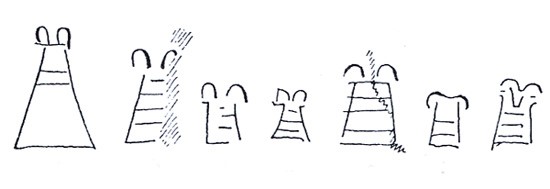
Ideograms from Knossos tablets that depict heavy cuirass/body armour. Image may be copyrighted.
The records on tablets and ideograms depictions provide us some interesting information. The heavy panoplies of Pylos follow the general design of the Dendra armour, formed of large horizontal plates. But there are some key differences compared to the armor of Knossos and Mycenae/Tyrins:
- Pylos Ideograms depict no large pauldrons, shoulders seem not to be protected. Term e-po-mi-jo (επώμιο) also is not mentioned in Pylos tablets
- Oversized gorgets and helmets are clearly visible
- Pylos tablets mention the term o-pa-wo-ta (referring to armor part / components), followed by numbers (eg. 12 small, 24 large) – this is interpreted as number of armor components. in this case the number is not compatible with Dendra armor design
- Pylos tablet Sh 736 mention as helmet components four (4) o-pa-wo-ta (κρεμάσματα) and two (2) pa-ra-wa-jo (παραγναθίδες), referring to a heavy helmet item

Ideograms from Pylos tablets that depict heavy cuirass/body armour. Image may be copyrighted.
Taking into account the above, we can assume that Pylos Kingdom was commissioning panoplies of 2 categories:
- heavy ones, Dendra type
- composite ones, leather/linen reinforced with large number of o-pa-wo-ta (30 – 40 plates, omfaloi and mitres)
- heavy compostite helmets
————————————–
A mix of weapons and helmets was used during the drills. We may be «accused» from «friends» for creative anachronism or lack of historical accuracy, but we did this intentionally as we do believe that materials and weapons were reused through time and across geographic areas. We also had to operate with budget constrains at a time of continuous economic crisis 🙂
Please keep in mind that the scope of the specific drills was to test specific combinations of panoplies and weapons in specific scenarios, it is NOT a general presentation intended to reenact a point in time, in the most possible historically accurate way… NOR is a guide for best practices of weapons use… NOR is an academic paper or thesis… NOR was intended to test the effectiveness of the weapons against the armor… it is a free-style study about our 4 years work, cross-experiences and insight we have gained in the area 🙂
————————————–
The drills were performed with the key contribution of Athanasios Barkas and MMA practitioners with the required skills and fitness to operate with weapons and heavy panoplies for extensive period of times. In order to analyze the drills, techniques and findings about using these exotic panoplies and weapons, we had long discussions with Mr Georgas (certified Trainer and Fencing Coach of the Greek Fencing Federation, Fechter of the Meyer Freifechter Guild, Member of the KORYVANTES Association).
Sources
- Homer – The Iliad
- Dan Howard, » Bronze Age Military Equipment»
- Barry Moloy,»Martial Minoans: War as social process, practice and event in Bronze Age Crete»
- Andrea Salimbeti
- Åstrom, Paul. «The Cuirass Tomb and Other Finds at Dendra, Part I: The Chamber Tombs.» Studies in Mediterranean Archaeology, Vol. IV. Goteborg, Sweden, 1977
- Hulit, Thomas David (2002) Late Bronze Age scale armour in the Near East : an experimental investigation of materials, construction, and effectiveness, with a consideration of socio-economic implications. Doctoral thesis, Durham University
- Periklis Delligiannis
- Paulus Hector Mair, Fiore dei liberi, Johannes Liechtenauer, Hans Talhoffer, Sigmund Ringeck
We would liked to specially thank Andrea Salimbeti for his exceptional site that has provided not only a wealth of information but also the inspiration to initiate the project in 2011.

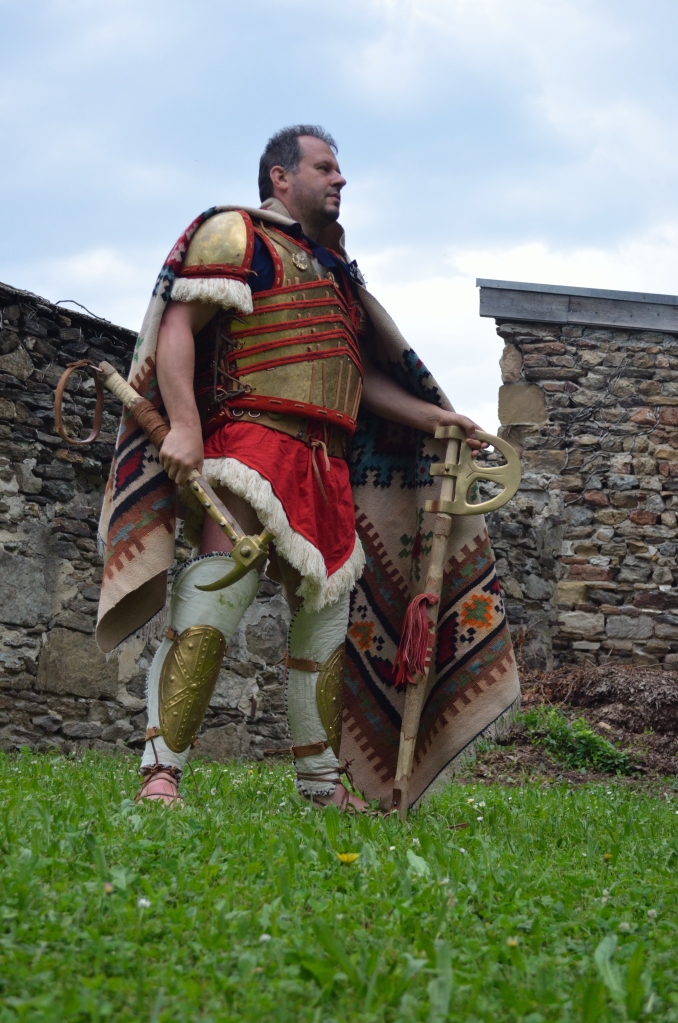
















Spectacular Blog. !!
Μου αρέσει!Μου αρέσει!
Thank you Rita, your comment is of most importance for us 🙂 Adonis
Μου αρέσει!Μου αρέσει!
Thank you so much fo this post. It has been amazingly insightful to me of the complexity and quality of craftsman of these earlier empires in our history.
Μου αρέσει!Μου αρέσει!
we also thank you for your kind communication 🙂
Μου αρέσει!Μου αρέσει!